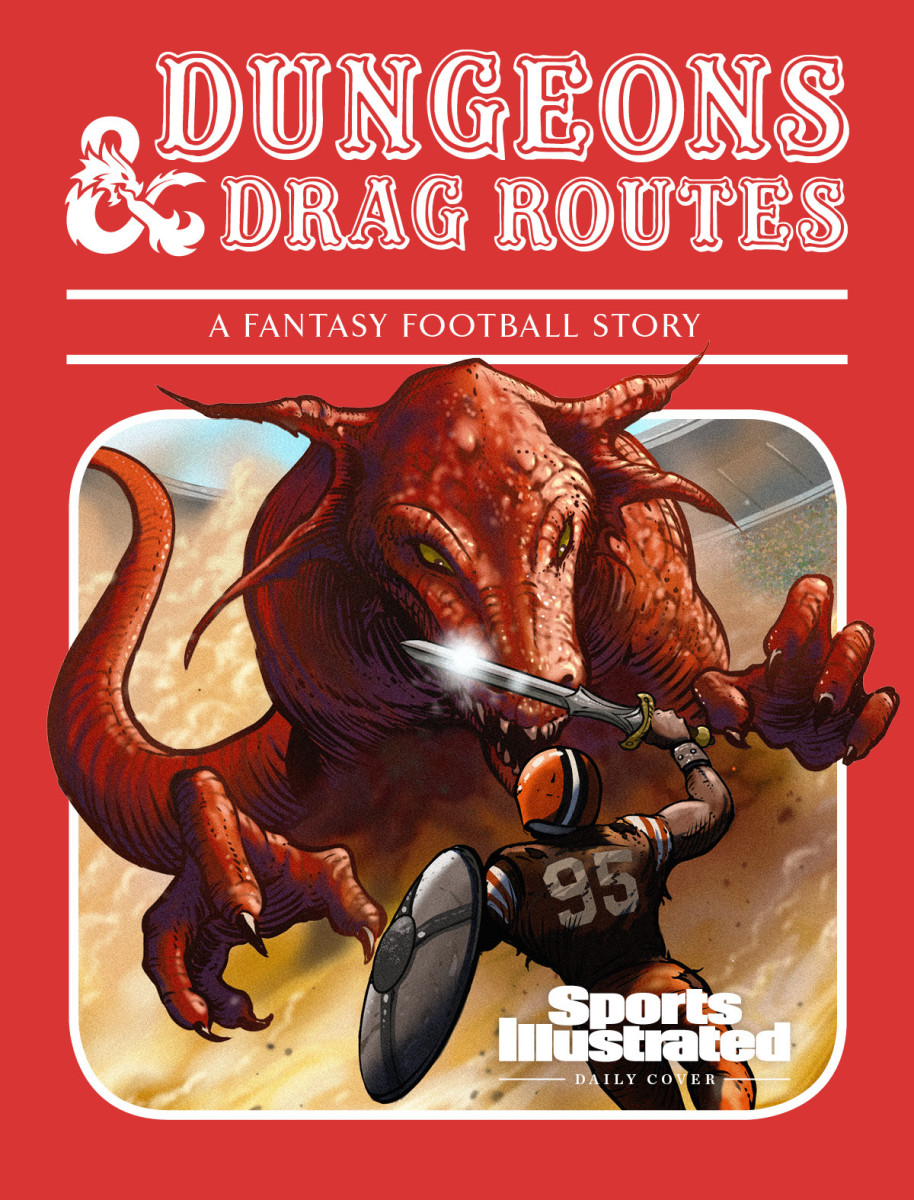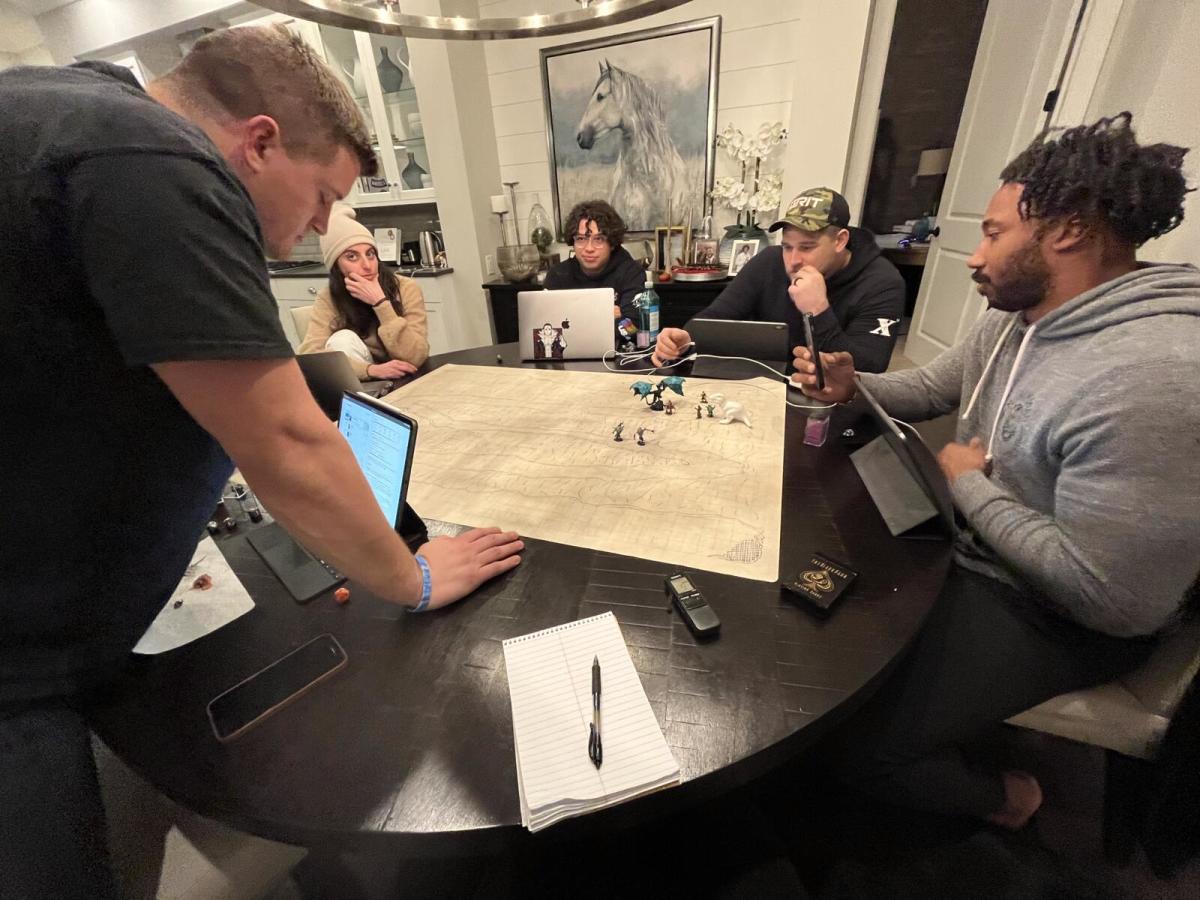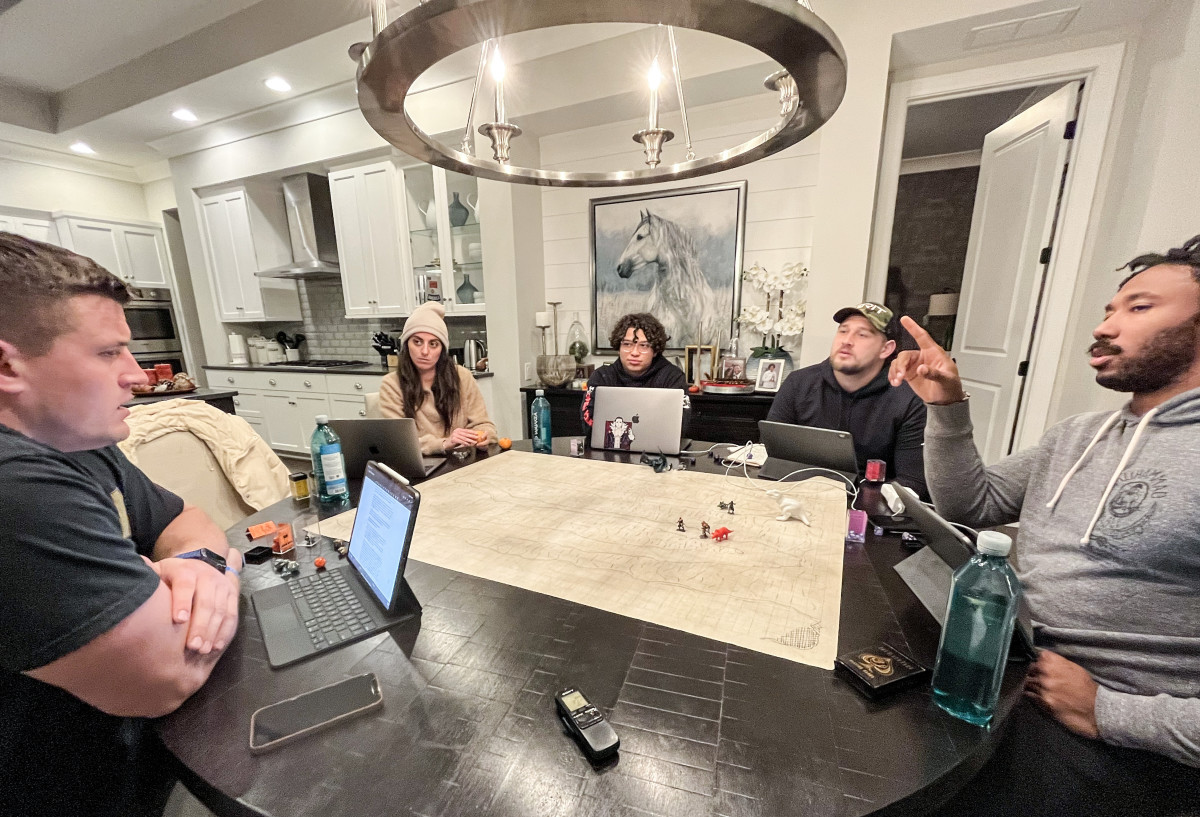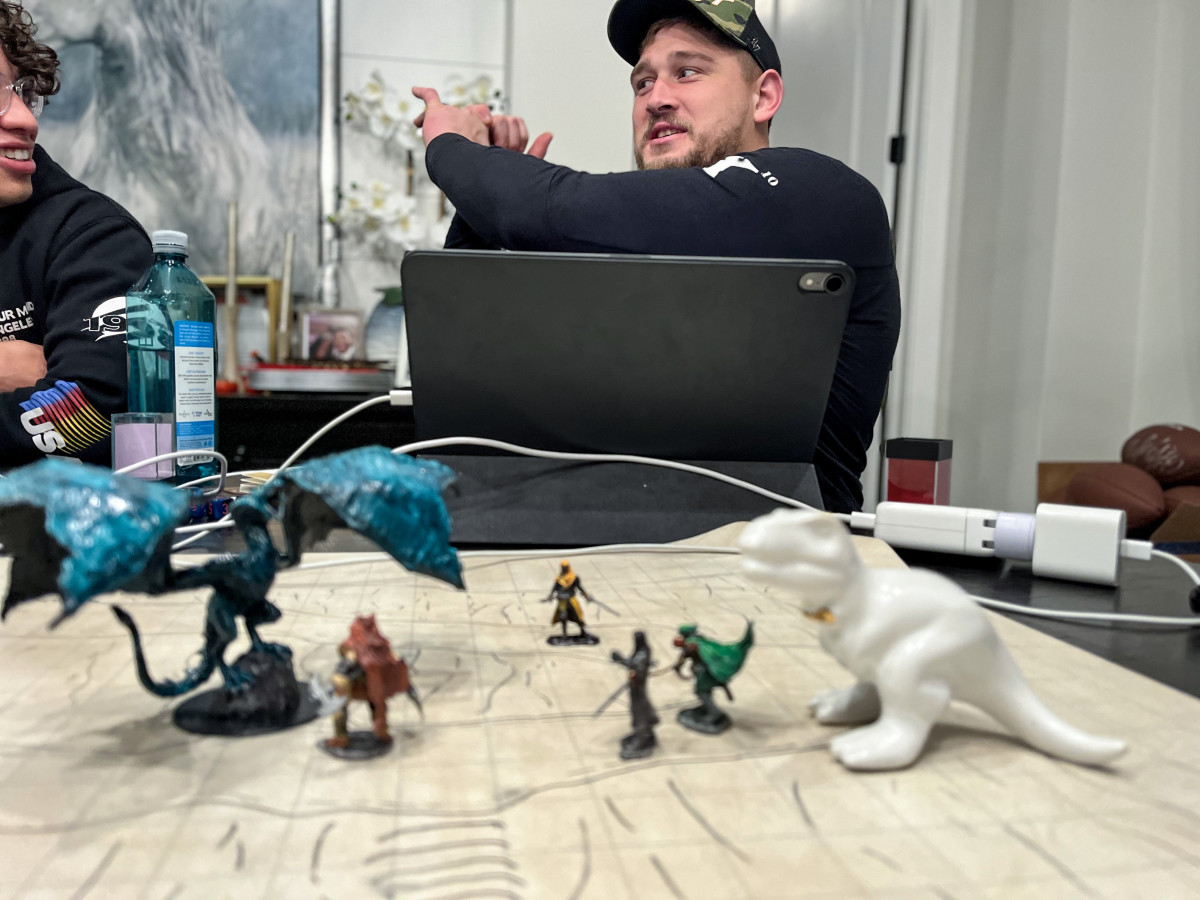Role Players: Myles Garrett and His Teammates Have Embraced Dungeons and Dragons

A violent screech disturbs the quiet sky, high above four heroes scaling a steep switchback trail on the side of a mesa. Craning up, they are greeted by the sight of a massive, menacing foe: an undead wyvern with rank, rotting skin, a poison-tipped tail and gobs of acidic ichor dripping from its exposed bones.
Down along the rocky path, as his companions dash for cover, Alucard Tepes turns to face the beast, his vampiric eyes alight. In one practiced motion, the champion fighter whips a bolt from the quiver on his back, loads it into his crossbow, shuts an eye, clicks his tongue and fires.
“Let it fly!” Alucard hollers.
The bolt soars through the air, striking the wyvern in its chest. Enraged, it shrieks again and dives at Alucard, who unsheathes his rapier, steeling himself for combat.

Myles Garrett was on a mission. Soon after he reported to Browns training camp in late July, displaying a level of urgency ordinarily reserved for the pursuit of doomed quarterbacks, the edge rusher extraordinaire tracked down teammate Johnny Stanton with a burning question. “When he showed up,” Stanton recalls, “pretty quickly Myles was like, ‘Hey, so, when are we gonna start up again?’”
A fullback on the roster fringes, Stanton balked at first, wary of making social plans before he’d made the team. But Garrett refused to relent, approaching Stanton whenever their paths crossed in the locker room or on the field. “He was still bugging me about it: ‘When are we gonna play, when are we gonna play?’” Stanton says. Finally, a month or so later, Cleveland signed Stanton to its practice squad, affording him enough job security to commit:
The Dungeons and Dragons game was back on.
These days, the NFL’s first letter might as well stand for nerd. From comic books to anime, video games to board games and beyond, there are more geeky outlets than ever through which athletes proudly unwind. For Garrett and All-Pro Browns guard Wyatt Teller, this takes the form of regularly gathering around a table in Garrett’s house to roll dice and role-play while Stanton, their almighty dungeon master (DM), serves up a home-brewed fantasy saga of puzzles to solve, people to save and bloodthirsty baddies to slay.
The group first came together in September 2020 at Stanton’s behest; as the only one with any prior D&D experience, the DM began by helping everyone choose characters. Prioritizing stealth over strength, Garrett built a half-elf rogue assassin named Garrett the Gray, a nod to both Gandalf and Will the Wise. Teller, too, was inspired by J.R.R. Tolkien in creating Flapper, a lumbering half-orc berserker barbarian with meaty hands and a habit of flying into rages during battle. “The orcs in Lord of the Rings, they wore those loincloths with little flaps on them,” Teller says. “So I thought Flapper would be fitting.”
Rounding out the adventurers were Shiloh the human monk (played by then Browns tackle Kendall Lamm), Meel the elven ranger (Garrett’s girlfriend Serra Tumay) and Jtachi the aasimar wizard (Garrett’s best friend Jeremy Medina). At Garrett’s suggestion, the group dubbed itself the Heathens.

The journey started at a plodding pace: With the NFL’s pandemic protocol limiting social gatherings for much of the 2020 season, and no one really interested in playing over Zoom, the Heathens were able to hold only three sessions last September and October. Still it was enough time for the beginners to get a hang of the D&D 5th Edition’s dense mechanics; accept a quest investigating some missing coal miners from the fantasy town of Phandalin; kill an undead owlbear; and encounter their campaign’s main villain, the Mold Father, in his cavernous lair before he fled through a secret tunnel. (Flapper tried to stop the escape by hurling a lasso fashioned out of rope from his equipment sack, but Teller failed the die roll that would determine whether the attempt succeeded.)
The party finally returned to the table this season, much to Garrett's delight. Big changes awaited. Lamm had signed with the Titans in free agency and thus couldn’t play anymore; Garrett meanwhile wanted to make a new character, Alucard, based on the half-vampire of the same name from the video game Castlevania. Stanton’s creative solution, upon gaining approval from both players, was to narrate a scene in which Shiloh and Garrett the Gray bravely sacrifice themselves to the Mold Father so their companions could survive, after which the remaining three Heathens find Alucard on the side of the road and convince him to join them. “And then they just moved on,” Stanton says, “like nothing had really happened.”
What actually goes on in a typical session, and how many hours it drags on for, often depends on whether the Heathens care to chase treasure, engage with helpful village folk and otherwise take advantage of D&D’s open-world format. “Wyatt likes to be a force of chaos,” Stanton says. “Myles is more roguish. Like if everyone is slow to do what he wants, he’ll just go off and do it.” The foursome doesn’t quite put the “role” in role-playing—no one dresses up, and only Stanton does character voices—but they take their sessions seriously. Dice are kissed for good luck or swapped for backups after lousy rolls. Teller-as-Flapper wears his emotions on his armored sleeves, hollering his catchphrase at every glimpse of a gold piece: Give me the money! Out of superstition Garrett refuses to sit next to Stanton, who as DM sets the mood with background music on his iPad, cranking up bass-heavy beats if the party is in combat or winding down to some woodwinds for a casual stroll.
As with any in-season hobby, of course, fantasy must fit around football. The night before signing a four-year deal to become the NFL’s third-highest-paid guard last month, Teller was so wiped from contract talks that he recalls “almost falling asleep” while playing as Flapper. Later in November, after the Browns were pummeled by the Patriots, Garrett, whose 14 sacks rank second league-wide, postponed what was scheduled to be the last session of their campaign to instead host a players-only meeting for the defense.
But those worries fade when the dice (and spells) are cast. After all, the point of D&D isn’t to improve the Browns’ on-field chemistry. Nor is it about the snacks, top-notch as they are: past selections from Garrett’s personal chef, whom everyone calls Chef, include chicken parm and bruschetta. And it definitely isn’t to fuel their competitive juices. “It’s not DM vs. players,” Stanton explains. “I’m trying to make the challenge hard enough so it feels worth it, but I'm still trying to still make you feel really cool.”
It adds up to a bonding experience unlike any across the NFL, even if the mere mention of the game itself still triggers some chuckles in stodgier corners of the Browns’ locker room. “It’s funny how people will give me s---,” Teller says. “But moments you spend together are more important than guys being like, ‘Hey, what are you doing playing friggin’ D&D?’ Well, it’s fun. It’s different, but it’s a good time.”

Back on the trail, the fight with the wyvern rages. Lasso in hand, Flapper tries to scurry up an escarpment, seeking to gain the advantage of higher ground. Instead he slips on a loose rock, bludgeoning himself in the steep fall.
Fortunately the rest of the Heathens are more proficient; not even the sudden appearance of two undead wights fazes them. After chipping away at the wyvern’s health, Meel the ranger lands the critical blow with back-to-back arrows from her longbow, sending the creature tumbling down the cliffside. Jtachi decapitates one of the wights with a magic missile. Alucard removes the other’s arm with his rapier —“I’m chopping that b----!” he roars—before performing a spin move to slit its throat.
Nursing their damage with potions and healing spells, the heroes hustle to the top of the mesa. There in the distance they find a large, circular stone door, framed by overgrown vines and caked in black sludge, guarding the mouth of a shallow cavern. They recognize this ooze at once: It is the telltale sign of their enemy, the terror of Phandalin and the reason for those missing miners.
It means the Mold Father is near.
As fantasy role-playing newbies who discovered D&D during the pandemic, Garrett and Teller are far from alone; last year the company that owns D&D, which first came out in 1974, reported a record 33% spike in sales of its instructional books. The desire for escapism is an obvious fueling factor here. (The endorsement of celebrity enthusiasts like Vin Diesel, Terry Crews and True Blood beefcake Joe Manganiello surely helped, too.) But it has also never been easier to get involved thanks to the D&D community’s many shows, podcasts, streams, forums, stat-tracking apps and mapmaking tools helping turn a once-niche gaming genre mainstream.
Stanton fell in love with D&D in an old-fashioned way: He wandered into his favorite local comic-book store, where he was already a regular, and asked to join the weekly game. (“I played a tabaxi rogue, which I feel like is a cliché first character now,” Stanton says.) Then a jack-of-all-trades senior at UNLV logging snaps on offense, defense and special teams, Stanton later convinced some unwitting teammates to let him DM for them, writing a campaign heavily cribbed from the plot of the D&D podcast, The Adventure Zone. But they managed to complete only four sessions before disbanding for graduation. “We didn’t get very far,” Stanton laments.
Then, as an undrafted free agent at Vikings training camp in 2018, Stanton suffered a season-ending ankle injury. Sent home to heal, he made a Reddit account and found a local D&D group of strangers that needed a new member. “We’re still friends to this day,” Stanton says. “I feel like I won the lottery on that one.” Distance forced him to leave that game when he signed with the Browns in early ’20, but Stanton continued to find ways to get his fantasy fix: When the pandemic first hit, the Southern California native started a campaign for his girlfriend and her family that picks up where they left off whenever they get together.
All the while, though, Stanton kept his passion private at work. “It wasn’t a thing I shared,” he says. “I wasn’t as always unabashed in my fandom, and I wasn’t really anywhere for long enough where I felt like I could put that kind of trust into somebody.” That changed one day last season when Stanton saw Garrett wearing a Stranger Things T-shirt at the Browns’ facility and summoned the courage to ask whether Garrett had ever considered playing, like the kids on the show. “I might be into trying it,” Garrett replied.
That was good enough for Stanton. “At that point the search was on for other guys on the team to play,” he says. “It was like, who the hell do I ask now?” But finding eager adventurers was easier than he thought. A friend of Stanton’s on the Browns’ offense, Lamm joined next, later roping in Teller; together, on top of a full spread of Raising Cane’s chicken, the two linemen also brought fleshed-out backstories for Flapper and Shiloh to their first session. “We were gladiators together,” Teller explains. “We started working for hire, came into this group.”

For Stanton, spreading his passion is part of the fun. It’s why he bought starter sets of various-sized dice for all the Heathens, and why he paints mini figurines of each player’s character, placing them on the maps that he draws to help visualize their fantasy world. It’s also why he hands over the storytelling reins to the players whenever possible, teeing them up to describe the action of slaying an enemy—provided they succeed on the requisite attack roll—with a simple question made famous by the popular D&D show Critical Role: How do you want to do this? “Especially when they get into it,” Stanton says, “that’s really rewarding.” And why he gushes with pride in describing Garrett’s research initiative upon deciding to kill off Garrett the Gray: “I show up to his house that night, and he’s looking at how to make Alucard [from Castlevania] into a D&D character,” Stanton says.
Equally gratifying has been the love Stanton receives whenever he posts about D&D on social media. When cameras captured him repping Critical Role before a Thursday-night matchup against the Broncos—during which he also caught his first career touchdown—a handful of Stanton’s favorite players and dungeon masters started following him on Twitter. A few weeks later he tweeted a picture of the Heathens for the first time. (Caption: “Been fun introducing these guys to DnD. Who says jocks can’t be nerds too?”) It has since earned more than 5,500 likes. “A lot of people said, ‘My two favorite things, the Browns and Dungeons and Dragons, are coming together,’” Stanton says.
Representation matters in growing any game. “It’s really important for people who do play, especially if you have a platform, to talk about it,” says former Cowboys center Travis Frederick, a longtime D&D player and cofounder of Demiplane, a software platform for tabletop role-playing gamers. “I want people to understand that it’s mainstream, and that more people play it than you think. When people hear that, their stereotypes start to shatter.” But not everyone is as open to sharing. “I know there are other people [in the NFL] who do it,” Frederick says, “I just don’t know who they are.”
For his part, Stanton certainly wouldn’t protest if football players killed time during road trips by whipping out their character cards and fighting monsters in the back of the team charter. “That’d be really fun,” he says. But as one lone DM his reach has limits. “I really enjoy introducing people to D&D,” Stanton says. “But I like to do it in a more personal way, rather than trying to explode its popularity throughout the sports world. Not everybody’s gonna be into D&D. And it works much better when someone you’re close with offers it to you as a chance to hang out.”
So he pours his creative energy into his story lines instead, maintaining “like 17” notes on his phone with ideas for future settings, plots and villains. In scheming what dangers would await the Heathens, Stanton was primarily inspired by two sources—a spindly, circle-of-spores druid figure with a wooden mask who had haunted one of his old D&D groups, and an episode of the medical podcast Sawbones about the origins of death certificates.
“They talked about how there weren’t actual scientific ways of describing what people died of,” Stanton says. “So the causes are things like ‘king’s evil’ [for a skin condition supposedly curable by a touch from royalty]. And ‘planet struck,’ for an act of God-like lightning. And then the last one was ‘mold-fallen,’ which basically just meant the flu, but I thought could be great for an enemy who created these undead beings.”
Thus was born the title of the Heathens’ first D&D campaign:
The Tale of the Mold-Fallen.

A push of a hidden button causes the stone door to swing open, revealing a room lit by two torches. As the Heathens step inside, the door shuts behind them with a heavy thud, leaving no exit in sight. A hint is written on the wall, albeit in a trade language known as Undercommon that only Jtachi the wizard can decipher. “The more of me there is, the harder it is to see,” it says. “What am I?”
Taking initiative, Flapper snuffs out both torches and waits. Darkness fills the space. Then, suddenly, at the far end of the room, a third torch lights and another door opens.
“Oh, bro,” Flapper cries, “that’s the first time I’ve done anything good!”
The party descends deeper into the mesa, encountering deadly riddles, traps and mazes along the way. Finally, at the end of a long ramp, they find the force of evil they have been seeking. There a pale, spindly man stands atop a platform, surrounded by a pool of inky blackness on all sides, chanting and waving his hands. A single tendril rises out of the pool and flows into his mouth.
“I have power now that I could never before fathom,” the Mold Father hisses. “The Rot has gifted me with this last lesson. We are becoming one, and no one can stop us now. Least of all you.”
More tendrils emerge, engulfing the man’s body to form a towering humanoid shape of sticky sludge. The Mold Father is no more. Here now stands an even bigger, evolved form of elemental evil, the ultimate boss of their quest: the Rot Father.
“Rot Father?” Alucard says, scoffing. “Ugly as hell! God-d-d-damn!”
As Garrett delivers this diss, the table howls with laughter. It’s two days before Thanksgiving, and two hours into the rescheduled final session of the Heathens’ campaign. They have beaten the wyvern and the wights; survived the mesa of trials; and, against all odds, let Stanton give his full Rot Father monologue without interrupting to attack. (“It’s like a love letter that you’ve worked so hard on, and are allowing the party to kill,” Stanton says of villain speeches.) Now the final battle is nigh.
Aside from the fact that this home belongs to the NFL’s current defensive player of the year favorite, it would be hard to imagine a more stereotypical—read: nerdy—D&D scene. Character sheets are queued up on laptops and tablets through D&D Beyond, the game’s online companion. Empty pizza boxes are piled on a nearby counter. (No Chef tonight.) Stanton is wearing a T-shirt that says “Paladin,” an homage to the pious D&D class, above three swords forming a holy triangle. An intense instrumental swells from his iPad; a hand-drawn map details the layout and terrain of the Rot Father’s hideaway.
Positioned around the map, flanking the much larger, much uglier form of the Rot Father, are the meticulously painted miniatures of Alucard, Flapper, Jtachi and Meel. As Stanton didn’t bring enough extra figures to account for animal familiars, a T. rex–shaped salt shaker is doubling as Meel’s dire wolf Gohan—named for Tumay and Garrett’s dog Gohan, who in turn was named for the Dragon Ball Z character—and a toy triceratops stands in for the giant elk that Flapper pulled from his magical “bags of tricks.” (Garrett’s similarly geeky passion for dinosaurs is well documented.)
Until Stanton first approached them about playing last year, neither Garrett nor Teller knew about D&D beyond the fact that it existed; the former was more into anime, and the latter believed it to be a board game. Look how into it they are now. Teller spends the night scribbling in a notebook to better track the constantly shifting dialogue and action. And when Alucard slices off the wight’s arm on the trail, Garrett rises from his seat, unsheathes an imaginary rapier and pretends to do the same to a visiting reporter.
“I probably wouldn’t be close with Myles if it wasn’t for D&D,” Stanton says. “Offense and defense don’t overlap much, hanging out. But this is a great way for me to connect with my teammates. Allowing myself to have fun with these guys and break down walls and talk like a weirdo about this fantasy stuff for a while, that’s probably not something that’s shared throughout every team.”
Maybe that is changing, especially as the popularity of tabletop roleplaying games grows and the stereotypical divide between jocks and nerds shrinks. “Football’s not an overly artistic game,” Frederick says. “A lot of people have a ton of creativity and are looking to get it out.” People like Bears linebacker Cassius Marsh, a big-time Magic: The Gathering buff, who plans to join his first game this offseason, DM’ed by Manganiello, the friend, actor and Steelers superfan. “Globally, I think it’s become more popular and a bigger part of the culture,” Marsh says, speaking in general about fantasy role-playing and other nerdy pursuits. “I think that’s spread into locker rooms.”
Certainly this is true in Cleveland, where Teller recalls recently striking up a casual conversation with Browns right tackle Jack Conklin about how Conklin’s father played in college in the 1980s and ’90s. “He definitely didn’t think of it as having a weird stigma,” Teller says of the younger Conklin. “I guess it is to certain people.” But even trolls are worth engaging. “[Browns quarterback] Baker [Mayfield] being Baker, he’ll be like, ‘Oh, wow, you go play D&D. What’s up with that?’” Teller says. “And I’m like, ‘Have you ever played? Do you like Skyrim, Fallout—games that you’re actually playing as a character?’ And he goes, ‘Well, yeah, of course!’”
Stanton also reports hearing from several current and former teammates, including Browns guard Joel Bitonio and Texans cornerback Terence Mitchell, about their interest in one day taking up fantasy arms. “Hopefully in the future I can play with them.” Stanton says. “If I ever end up not on the same team as Myles and Wyatt, I could see myself bringing it up to guys who are more into openly nerdy stuff, too.”
As it is, Garrett has already started bugging Stanton for more. “When I told him it was our last session, Myles was like, ‘O.K., but what are we going to do after this?’” Stanton says. Should the Browns’ group reunite for another mission—perhaps in a charity game that Stanton hopes to run and stream next offseason to benefit Garrett’s charity, Waterboys—their fearless DM won’t lack for plotlines. “I went to see Dune and got so many ideas,” Stanton says, declining to specify out of fear of giving away spoilers. If not their efforts won’t have been in vain, either. “Even if I don’t know if I’ll start a D&D club back home,” Teller says, “it’s something that I can start now, because I put my toe in the water.”
On this night, the Heathens find their toes not in water but a primordial ooze, borne from the Rot Father’s necrotic powers, yanking them down like quicksand and dealing poison damage. Complicating matters is the presence of several Rot Father underlings—“rot spawns”—capable of destructive self-detonation. Facing this phalanx, the battle gets off to a bad start: Flapper spends several harrowing minutes blinded, restrained and breathless inside the Rot Father’s goopy innards, having been swallowed whole.
As usual, though, the Heathens persevere. Flapper’s giant elk and Gohan the dire wolf act as meat shields, providing Jtachi cover to sling firebolts and psychic spells. Flapper finally wriggles free from the Mold Father and heaves his greatsword, chopping off chunks of its sludgy body. It hardly matters when Garrett fails a roll to evade a melee, knocking Alucard unconscious and causing Garrett to sigh in exasperation. Before long another arrow from Meel’s longbow flies at the Rot Father, and Stanton turns to Tumay with the glint of a DM who knows he’s beat. Together, as hour five nears, the whole table gleefully hollers those seven magic words that mark a successful kill:
“How do you want to do this?”
The Rot Father has fallen. The town of Phandalin is saved. The Heathens are celebrated as heroes, partying deep into the fantasy night.
It feels really cool.
Read more of SI's Daily Cover stories here:
• How a QB Evolution Sparked a Coaching Revolution
• How Does Dan Campbell Create a Winning Culture While Losing?
• How Steelers' Logo Helped Heal Pittsburgh After Synagogue Shooting
• Bowl Season Is Coming. And There Are Only 36 Pylons Left.

